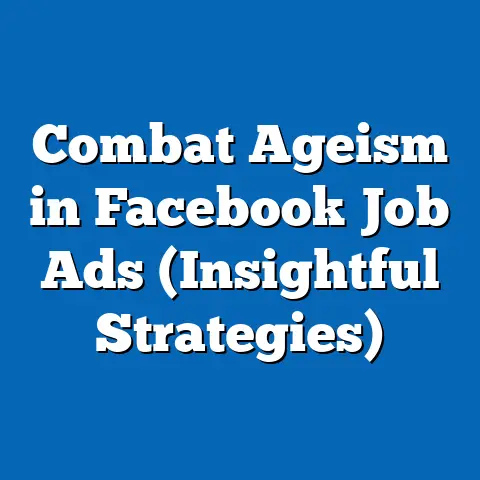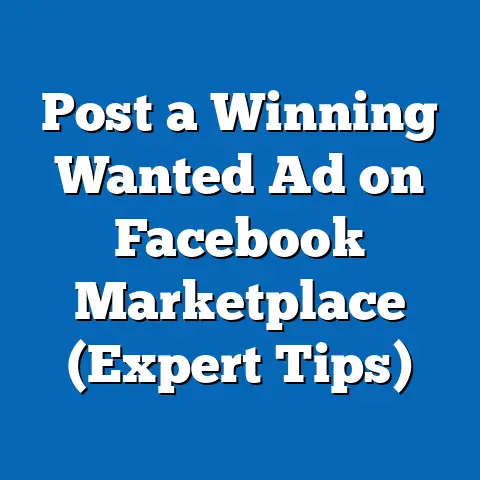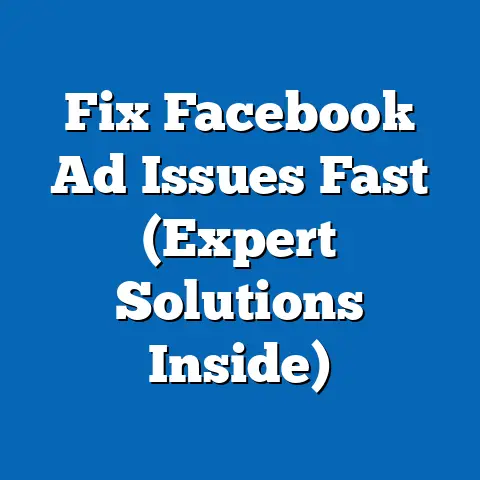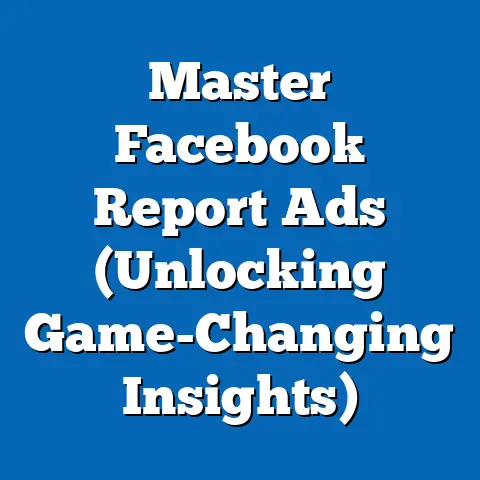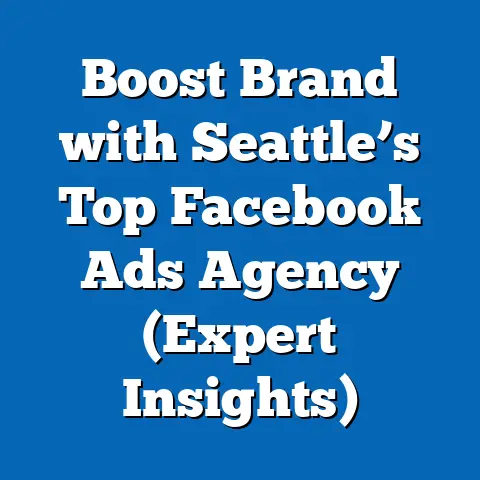Optimize fb ad Spend: 5 Affordable Clicks (Budget-Friendly Guide)
Facebook advertising. Just the thought of it can send shivers down a small business owner’s spine. I remember when I first started, I felt like I was throwing money into a black hole, hoping something would come out the other end. The fear of overspending and not seeing results is real, especially when you’re bootstrapping. But here’s the truth: Facebook advertising doesn’t have to be a budget-buster. In fact, with the right strategies, you can get those coveted clicks without emptying your bank account.
In today’s digital marketing landscape, Facebook remains a powerhouse. Did you know that Facebook’s ad revenue reached nearly $117 billion in 2022? That’s a staggering figure, and it highlights the platform’s potential for businesses of all sizes. However, the key is not just being on Facebook but being smart about how you spend your ad dollars.
Optimizing ad spend is essential, and I’m not just saying that. It’s about making every penny count, ensuring that your hard-earned money translates into tangible results. Especially for startups and small businesses, a lean budget requires a strategic approach. You can’t afford to waste money on ineffective campaigns.
This guide is designed to reveal five strategic yet budget-friendly methods to achieve affordable clicks on Facebook ads. I’ve been there, done that, and learned a lot along the way. This isn’t just theory; it’s practical advice based on real-world experience. We’re talking about maximizing impact without breaking the bank. Whether you’re a seasoned marketer or just starting, these insights will help you save money, improve campaign performance, and get the most bang for your buck. Let’s dive in and turn those advertising fears into confident strategies!
Understanding Facebook Ads
Before we jump into the nitty-gritty, let’s lay some groundwork. Understanding the basics of Facebook advertising is crucial for optimizing your ad spend. Think of it as learning the rules of the game before you start playing.
Facebook offers a variety of ad formats, each designed to capture attention in different ways. You’ve got:
- Image Ads: Simple, yet effective, image ads are perfect for showcasing your product or service with a single, compelling visual.
- Video Ads: Engaging and dynamic, video ads can tell a story, demonstrate a product, or capture attention with motion.
- Carousel Ads: Allow users to swipe through multiple images or videos, perfect for highlighting different features or products.
- Slideshow Ads: Combine images and text to create a visually appealing slideshow, ideal for showcasing a series of related products or benefits.
Each format has its strengths, and choosing the right one depends on your campaign goals and target audience.
Now, let’s talk about the heart of your Facebook advertising efforts: the Facebook Ads Manager. This is your command center, where you’ll create, manage, and analyze your campaigns. Key features include:
- Campaign Creation: Where you define your campaign objective (e.g., traffic, engagement, conversions).
- Ad Set Level: Where you define your target audience, budget, and ad placement.
- Ad Level: Where you design your ad creative (images, videos, text).
- Reporting Dashboard: Where you track key metrics like impressions, clicks, and conversions.
Monitoring these metrics is essential for understanding how your ads are performing and making data-driven decisions.
Speaking of metrics, let’s zoom in on Cost Per Click (CPC). CPC is the amount you pay each time someone clicks on your ad. It’s a critical metric for measuring ad spend efficiency. A lower CPC means you’re getting more clicks for your money, while a higher CPC could indicate that your ads aren’t resonating with your audience or that your targeting is off.
For instance, I once ran two similar campaigns with the same budget. One had a CPC of $0.50, while the other was $1.50. The first campaign generated three times as many clicks, proving that a lower CPC directly translates to more traffic and potential conversions.
Finally, one of the biggest influences on your ad costs is your target audience. The more specific and relevant your audience, the more likely they are to engage with your ads, which can lead to a lower CPC. Casting too wide a net can result in wasted ad spend and irrelevant clicks.
Key Takeaway: Understanding the basics of Facebook advertising, including ad formats, the Ads Manager interface, CPC, and audience targeting, is crucial for optimizing your ad spend and achieving affordable clicks.
Think of it like fishing. You wouldn’t use the same bait for trout as you would for sharks, right? The same principle applies to Facebook ads.Facebook’s audience targeting options are incredibly powerful, allowing you to pinpoint your ideal customer with laser precision. You can filter based on:
- Demographics: Age, gender, education, location, relationship status, and more.
- Interests: Hobbies, favorite brands, pages they like, and topics they follow.
- Behaviors: Past purchases, device usage, travel habits, and online activity.
These options are your toolbox for crafting the perfect audience.
But it doesn’t stop there. Facebook also allows you to create Custom Audiences, which are based on your existing customer data. This could include:
- Email Lists: Upload your customer email list to target those specific individuals.
- Website Visitors: Use the Facebook Pixel to target people who have visited your website.
- App Users: Target people who have downloaded and use your mobile app.
Custom Audiences are gold because they consist of people who already know and interact with your brand.
And then there’s the magic of Lookalike Audiences. These are audiences that Facebook creates based on your Custom Audiences, targeting people who share similar characteristics and behaviors. They’re a fantastic way to expand your reach while still maintaining relevance.
I remember working with a local bakery that wanted to promote their new line of gluten-free products. Instead of targeting everyone in the city, we created a Custom Audience based on their existing customers who had purchased gluten-free items. Then, we created a Lookalike Audience based on that Custom Audience. The result? A significant increase in engagement and sales, with a much lower CPC compared to their previous broad-targeting campaigns.
Refining your audience segments is key to improving ad relevance and lowering CPC. Here are a few tips:
- Layer Targeting Options: Combine demographics, interests, and behaviors to create highly specific audiences.
- Exclude Irrelevant Segments: Remove segments that are unlikely to convert.
- Monitor Audience Performance: Track which audiences are performing best and adjust your targeting accordingly.
Let’s look at a real-world example. A fitness studio in Austin, Texas, wanted to attract new members. Instead of simply targeting “people interested in fitness,” they layered their targeting to include:
- Demographics: Women aged 25-45 living within a 5-mile radius of the studio.
- Interests: Yoga, Pilates, healthy eating, and local fitness events.
- Behaviors: People who have recently purchased fitness apparel or equipment online.
By refining their audience in this way, they saw a 40% reduction in CPC and a significant increase in membership sign-ups.
Key Takeaway: Targeting the right audience is essential for achieving affordable clicks on Facebook. By leveraging Facebook’s powerful targeting options, creating Custom and Lookalike Audiences, and refining your segments, you can improve ad relevance, lower your CPC, and drive better results.
Click Strategy #2 – Crafting Compelling Ad Copy
So, you’ve got your targeting locked down, but that’s only half the battle. Now, you need to write ad copy that grabs attention and compels people to click. Think of your ad copy as your sales pitch – it needs to be persuasive, engaging, and relevant to your target audience.
Creating compelling ad copy is an art, but it’s also a science. Here are a few techniques to keep in mind:
- Know Your Audience: Speak directly to their needs, desires, and pain points. Use language that resonates with them.
- Highlight Benefits, Not Just Features: Focus on how your product or service will improve their lives. What problem does it solve? What value does it provide?
- Use Strong Verbs and Action Words: Encourage immediate action. Words like “Discover,” “Learn,” “Get,” and “Transform” can be incredibly effective.
- Create a Sense of Urgency: Limited-time offers, exclusive deals, and deadlines can motivate people to click now.
- Keep it Concise: People are scrolling quickly, so get to the point. Use short, punchy sentences and avoid jargon.
Your headline is the first thing people will see, so it needs to be attention-grabbing. Here are a few headline formulas that work:
- The “How To” Headline: “How to [Achieve Desired Outcome] in [Specific Timeframe]”
- The Question Headline: “Are You [Experiencing a Common Problem]?”
- The Benefit Headline: “[Achieve Desired Outcome] Without [Common Pain Point]”
Your call-to-action (CTA) is your final opportunity to encourage a click. Make it clear and compelling. Here are a few examples:
- “Shop Now”
- “Learn More”
- “Sign Up Today”
- “Get Started”
The key is to match your CTA to the overall goal of your campaign.
A/B testing is your secret weapon for optimizing ad messaging. By testing different headlines, descriptions, and CTAs, you can identify what resonates best with your audience. Here’s how it works:
- Create Two Versions of Your Ad: Change one element (e.g., the headline) while keeping everything else the same.
- Run the Ads Simultaneously: Allow both ads to run for a specific period of time.
- Track Performance: Monitor metrics like click-through rate (CTR) and CPC to see which ad performs better.
- Implement the Winner: Pause the underperforming ad and focus on the winning version.
I once worked with an e-commerce store that was struggling to get clicks on their ads. We ran A/B tests on their headlines, and we discovered that headlines that included a specific discount percentage outperformed those that simply said “Sale.” This small change resulted in a 30% increase in CTR and a significant reduction in CPC.
Let’s look at a few examples of high-performing ad copy and break down what made them successful.
Example 1: A SaaS Company
- Headline: “Stop Wasting Time on Tedious Tasks”
- Description: “Automate your workflow with our powerful software. Get a free trial today!”
- CTA: “Start Free Trial”
Why it works: The headline speaks directly to a common pain point (tedious tasks), the description highlights the benefit (automation), and the CTA is clear and compelling.
Example 2: A Local Restaurant
- Headline: “Craving Authentic Italian Tonight?”
- Description: “Enjoy delicious pasta, pizza, and more at [Restaurant Name]. Order online for delivery or takeout!”
- CTA: “Order Now”
Why it works: The headline appeals to a specific craving, the description highlights the restaurant’s offerings, and the CTA makes it easy to take action.
Key Takeaway: Crafting compelling ad copy is essential for driving clicks and lowering your CPC. By knowing your audience, highlighting benefits, using strong verbs, creating a sense of urgency, and A/B testing your messaging, you can create ads that resonate with your target audience and get them to click.
Click Strategy #3 – Creative Visuals that Convert
Now that you’ve nailed your targeting and ad copy, it’s time to focus on the visual elements of your ads. In a world of endless scrolling, your visuals need to stop people in their tracks. Think of your visuals as the first impression – they need to be eye-catching, relevant, and engaging.
Visual content plays a crucial role in ad performance. Here’s why:
- Grabs Attention: High-quality visuals stand out in a crowded newsfeed.
- Conveys Information Quickly: People process visuals much faster than text.
- Evokes Emotion: Visuals can create a connection with your audience and inspire action.
- Reinforces Brand Identity: Consistent visuals help build brand recognition.
The psychology behind images and videos is fascinating. Here are a few principles to keep in mind:
- Color Psychology: Different colors evoke different emotions. Use colors that align with your brand and message.
- Visual Hierarchy: Guide the viewer’s eye to the most important elements of your ad.
- Facial Expressions: Images of people, especially those with genuine expressions, can create a connection with your audience.
- Social Proof: Include images of happy customers or testimonials to build trust.
Selecting or creating high-quality visuals is essential. Here are a few tips:
- Use Professional-Quality Images: Avoid blurry, pixelated, or poorly lit images.
- Ensure Relevance: Your visuals should be directly related to your product or service.
- Maintain Brand Consistency: Use your brand colors, fonts, and style in your visuals.
- Test Different Visuals: A/B test different images and videos to see what performs best.
Given that a significant portion of Facebook users access the platform via mobile devices, mobile optimization is critical. Here are a few tips:
- Use Vertical Videos: Vertical videos take up more screen space on mobile devices.
- Keep Text Concise: Use short, punchy text that is easy to read on small screens.
- Use Clear CTAs: Make sure your CTAs are visible and easy to tap.
- Test Mobile Performance: Preview your ads on different mobile devices to ensure they look good.
Video ads can be a cost-effective way to engage users. Here’s why:
- Higher Engagement: Videos tend to generate more engagement than static images.
- Tell a Story: Videos allow you to tell a more compelling story about your brand.
- Demonstrate Products: Videos are great for showcasing how your product works.
- Cost-Effective: Video ads can often achieve a lower CPC than image ads.
I once worked with a clothing boutique that was struggling to get traction with their image ads. We decided to try video ads, showcasing models wearing their clothes in different settings. The result was a dramatic increase in engagement and sales, with a much lower CPC compared to their previous image ads.
Key Takeaway: Creative visuals are essential for capturing attention, conveying information, and driving clicks. By understanding the psychology behind images and videos, selecting high-quality visuals, optimizing for mobile, and leveraging video ads, you can create ads that resonate with your target audience and achieve affordable clicks.
Click Strategy #4 – Budget Management Techniques
You’ve got your targeting, ad copy, and visuals dialed in. Now, let’s talk about the money. Effective budget management is crucial for maximizing your ROI and achieving affordable clicks. It’s not just about spending less; it’s about spending smarter.
Setting a realistic budget is the first step. Here are a few factors to consider:
- Campaign Goals: What are you trying to achieve? More traffic? More leads? More sales?
- Target Audience Size: The larger your audience, the more you’ll need to spend to reach them.
- Competition: How many other advertisers are targeting the same audience?
- Projected Returns: How much revenue do you expect to generate from your campaign?
A good starting point is to allocate a small budget for testing. Run a few different ad variations to see what performs best, then scale up your budget based on those results.
Facebook offers two main types of budgets:
- Daily Budget: The average amount you’re willing to spend each day.
- Lifetime Budget: The total amount you’re willing to spend over the entire duration of your campaign.
Daily budgets are great for ongoing campaigns, while lifetime budgets are better for campaigns with a specific end date.
I prefer using daily budgets for most of my campaigns because they give me more flexibility to adjust my spending based on performance. If an ad is performing well, I can increase the daily budget to reach more people. If it’s not performing well, I can decrease the budget or pause the ad altogether.
Facebook offers two main bidding strategies:
- Automatic Bidding: Facebook automatically sets your bids to get the most results for your budget.
- Manual Bidding: You set your own bids based on how much you’re willing to pay for each click or impression.
Automatic bidding is a good option for beginners, as it takes the guesswork out of bidding. However, manual bidding can be more effective if you have a good understanding of your target audience and the competitive landscape.
Leveraging Facebook’s algorithm for cost savings is key. Here are a few tips:
- Optimize for Conversions: Tell Facebook that you want to optimize for conversions (e.g., purchases, leads) rather than just clicks.
- Use the “Lowest Cost” Bidding Strategy: This tells Facebook to get you the lowest possible cost per result.
- Allow Facebook to Learn: Give Facebook’s algorithm time to learn and optimize your campaign.
Monitoring ad performance is essential for optimizing budget allocation. Here are a few metrics to track:
- CPC (Cost Per Click): How much you’re paying for each click.
- CTR (Click-Through Rate): The percentage of people who see your ad and click on it.
- Conversion Rate: The percentage of people who click on your ad and complete a desired action (e.g., purchase, sign-up).
- ROI (Return on Investment): The amount of revenue you’re generating for every dollar you spend.
Based on these metrics, you can make adjustments to your budget, targeting, ad copy, and visuals to improve performance.
I once worked with a client who was overspending on their Facebook ads without seeing any results. We analyzed their campaign performance and discovered that they were targeting a broad audience with generic ad copy. By refining their targeting, crafting more compelling ad copy, and optimizing their bidding strategy, we were able to reduce their ad spend by 50% while still achieving the same number of conversions.
Key Takeaway: Effective budget management is crucial for maximizing your ROI and achieving affordable clicks. By setting a realistic budget, understanding the different budget types, leveraging Facebook’s algorithm, and monitoring ad performance, you can optimize your ad spend and drive better results.
Think of it like giving someone a second chance to buy from you. They’ve already shown interest in your brand, so they’re much more likely to convert.Retargeting and remarketing are strategies that involve showing ads to people who have previously interacted with your brand. This could include:
- Website Visitors: People who have visited your website but didn’t make a purchase.
- Email Subscribers: People who have subscribed to your email list but haven’t purchased anything.
- Social Media Engagers: People who have liked, commented on, or shared your social media posts.
The beauty of retargeting is that you’re targeting people who already know and trust your brand. They’re much more likely to click on your ads and convert than someone who has never heard of you.
Creating compelling ads specifically for retargeted audiences is key. Here are a few tips:
- Remind Them of What They Missed: If they abandoned their cart, show them the items they left behind.
- Offer a Discount: Incentivize them to purchase with a special offer.
- Highlight Social Proof: Show them testimonials or reviews from other customers.
- Create a Sense of Urgency: Limited-time offers can motivate them to take action.
Setting up retargeting campaigns using the Facebook Pixel is relatively straightforward. Here’s how:
- Install the Facebook Pixel: Place the Facebook Pixel code on your website.
- Create Custom Audiences: Create Custom Audiences based on website visitors, email subscribers, or social media engagers.
- Create Retargeting Ads: Create ads specifically for your retargeted audiences.
- Target Your Ads: Target your retargeting ads to your Custom Audiences.
I remember working with an online retailer that was struggling to convert website visitors into customers. We set up a retargeting campaign that showed ads to people who had visited their website but didn’t make a purchase. The ads featured the products they had viewed, along with a special discount code. The result was a significant increase in sales and a much lower CPC compared to their previous broad-targeting campaigns.
Key Takeaway: Retargeting and remarketing are powerful strategies for achieving affordable clicks. By targeting people who have previously interacted with your brand, creating compelling ads specifically for retargeted audiences, and setting up retargeting campaigns using the Facebook Pixel, you can lower your CPC and increase conversions.
Conclusion
We’ve covered a lot of ground, haven’t we? From understanding the basics of Facebook advertising to mastering advanced strategies like retargeting, you’re now equipped with the knowledge and tools to optimize your ad spend and achieve affordable clicks.
Let’s recap the five strategies we discussed:
- Targeting the Right Audience: Leverage Facebook’s powerful targeting options to pinpoint your ideal customer.
- Crafting Compelling Ad Copy: Write persuasive ad copy that resonates with your target audience.
- Creative Visuals that Convert: Use high-quality visuals that grab attention and convey information quickly.
- Budget Management Techniques: Set a realistic budget, understand the different budget types, and leverage Facebook’s algorithm for cost savings.
- Utilizing Retargeting and Remarketing: Target people who have previously interacted with your brand and offer them a second chance to buy from you.
Remember, these strategies aren’t just theoretical; they’re based on real-world experience and proven results. I’ve seen firsthand how these techniques can transform struggling campaigns into success stories.
Now, it’s your turn to put these strategies into action. Don’t be afraid to experiment, test different approaches, and track your results. The key is to continuously monitor your performance and make adjustments as needed.
I encourage you to implement these strategies in your own campaigns and to monitor results for continuous improvement. Share your experiences and any additional tips you may have for optimizing Facebook ad spend. We’re all in this together, and by sharing our knowledge and insights, we can help each other achieve even greater success.
So, what are you waiting for? Dive in, start experimenting, and watch those affordable clicks roll in! The world of Facebook advertising is vast and ever-changing, but with the right strategies and a willingness to learn, you can master it and achieve your business goals without breaking the bank.

